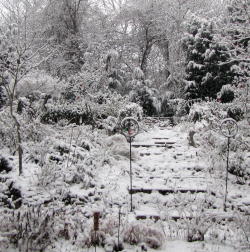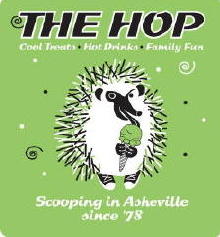 This has nothing to do with winter weeding but I thought it would grab your attention. Featured plants are Hydrangea Paniculata Grandiflora, purple perilla and yellow mirabilis, four o’clocks. Now that your attention has been grabbed…..
This has nothing to do with winter weeding but I thought it would grab your attention. Featured plants are Hydrangea Paniculata Grandiflora, purple perilla and yellow mirabilis, four o’clocks. Now that your attention has been grabbed…..
 Henbit, Lamium amplexicaule, shown here with a Redbor kale seedling. When we first moved here and these little seedlings, the henbit, not the kale, appeared in the winter, I happily thought some of my flowers had seeded themselves. They were similar in appearance to the catnip that also shows itself then. It was not until the flowers bloomed, purple dots on spikes, that I remembered it as a plant from my youth. Ubiquitous and mildly attractive. Okay, it is giving green healthy foliage at a time when green is a scarcity. Let it be. The problem began when it grew larger and larger, preventing the desirable volunteer babies from getting sun and nutrients.
Henbit, Lamium amplexicaule, shown here with a Redbor kale seedling. When we first moved here and these little seedlings, the henbit, not the kale, appeared in the winter, I happily thought some of my flowers had seeded themselves. They were similar in appearance to the catnip that also shows itself then. It was not until the flowers bloomed, purple dots on spikes, that I remembered it as a plant from my youth. Ubiquitous and mildly attractive. Okay, it is giving green healthy foliage at a time when green is a scarcity. Let it be. The problem began when it grew larger and larger, preventing the desirable volunteer babies from getting sun and nutrients.
 Out it came, but the seeds had already been sown. When a new area is cleared and hoed, the henbit returns by the hundreds. It is quickly pulled up now and I now feel sort of in control, for the time being.
Out it came, but the seeds had already been sown. When a new area is cleared and hoed, the henbit returns by the hundreds. It is quickly pulled up now and I now feel sort of in control, for the time being.
A true gardener’ bane. These put forth new growth in winter. They break off when pulled and make baby bulblets as well as seed if allowed to flower.
 These are amazingly offered in bulb catalogs as Allium ‘Hair’. Shown here with its friend, henbit.
These are amazingly offered in bulb catalogs as Allium ‘Hair’. Shown here with its friend, henbit.
 Sprays don’t affect it and digging up groups doesn’t seem to eradicate it. There must always be left in the ground some little tiny piece that will grow quickly into the noxious adult onion. This has grown right through landscape cloth, piercing it with the grass like foliage. When you attempt to dig or pull the offender, the bulbs are safely under the cloth, impervious to your efforts. This may be a battle that cannot be won.
Sprays don’t affect it and digging up groups doesn’t seem to eradicate it. There must always be left in the ground some little tiny piece that will grow quickly into the noxious adult onion. This has grown right through landscape cloth, piercing it with the grass like foliage. When you attempt to dig or pull the offender, the bulbs are safely under the cloth, impervious to your efforts. This may be a battle that cannot be won.
 This little weed has white flowers in spring on spikes. Can anyone help identify it?Added: This is hairy, or it might be bitter cress, Cardamine hirsuta.
This little weed has white flowers in spring on spikes. Can anyone help identify it?Added: This is hairy, or it might be bitter cress, Cardamine hirsuta.

Another shot of this weed’s winter look, with sedum and a foxglove seedling joining it between the pavers.
It is in the garden by the hundreds.













just pour scalding coffee on these around noon on february the 19th, just after the sun has peaked. also, make sure your back is facing north to inhibit your shadow from cooling the steaming liquid. i’ve been asked before if the coffee should have cream and sugar or be black. the answer is, as it was before: that is entirely up to you. personally, i like to put a teaspoon of soymilk in with my coffee. it seems to leave a nasty taste in the weeds’ mouths. once applied, you will notice a dramatic change. whereas before the weeds were green, they now have brown stains on them, which of course drives them crazy. i’d like to see them do anything about it. if they do, i’ll dig out their roots in a fit of earth-shaking rage. good luck.
brokenbeat…you are a wealth of knowledge, thanks.
I think your unknown weed may be hairy bittercress (Cardamine hirsuta). You can find more specific info here: http://www.ppws.vt.edu/scott/weed_id/carhi.htm. Or, Google either the common or scientific name. Hope that helps!
nan…thanks for that help. one always likes to know what one is dealing with.
I removed a large patch of that strawberry from my lawn by hand. It only took 2 summers… I’m surprised that Lysimachia can’t out thug it. I also have that catnip lookalike. It smells nasty!
I can’t help you with your mystery weed.
All I can say is that I have most of your other weeds. Happily they are covered with snow right now. I don’t have to think about them or worse yet see them. I am very good with denial. 🙂
I think I am sharing your henbit problem over her in middle TN. I think I eradicated most of the ragweed in the yard and now in it’s place is that weed! Boiling water works good for me to get rid of unwanted weeds. I’ve wondered about the wild onions…is there a good wild onion soup recipe? Maybe something similar to a leak soup? Might be a good way to get rid of them! Crazy thought probably. I’ve got quite a few of them too (onions that is) 😉
Also welcome to blogging from a fellow Tennessean!
MMD…I did smell the henbit and figured it was not an herb. Also, the jenny is on the slope, not its wet environ where it could fight the strawberry better. Thanks for your input.
Lisa…your snow is a good soil insulator. We are still in drought mode and could use the moisture.
dave…the wild onions do not taste good, they are strong. Thanks for the TN welcome. Why are there so few of us?
I have all of these weeds and more sprouting now. It loves this mild winter weather. UGH… Wild strawberry will kill even larger perennials. I don’t like it at all. I have chickweed blooming. Geez. I hope this 20degree weather puts a stop to that.
Chickweed is my winter nemesis!
We have some Poa annua coming up, my winter weed nemesis.